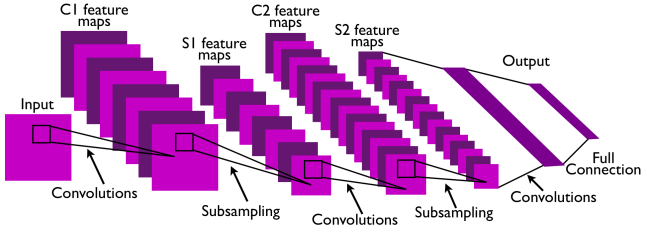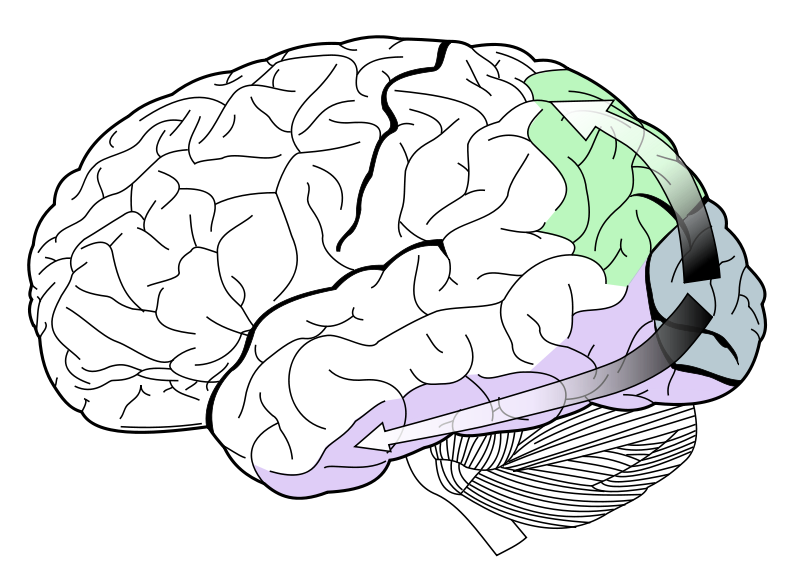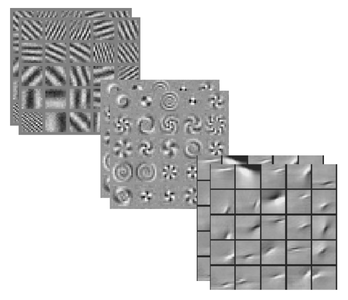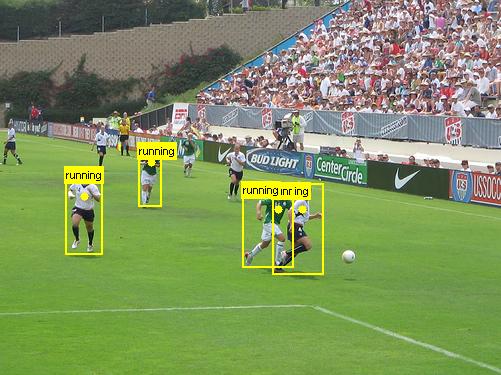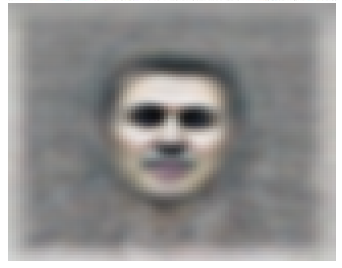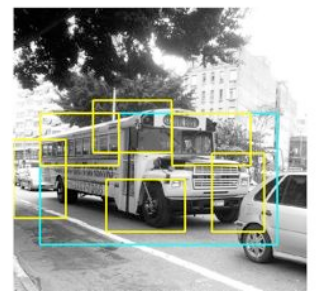| Introduction / background |
|
Date
|
Topic
|
Readings
|
Notes
|
|
Jan 6
|
Intro
|
|
notes
|
|
Jan 19
|
Review of basic probabilities/linear algebra/ML
|
|
notes
|
|
Jan 20
|
Lecture: Some biological aspects of vision
|
Reading 1: Attneave 1954
|
notes
|
|
Jan 26
|
Lecture: Back-prop and neural networks
|
Reading 2: sparse coding (Foldiak, Endres; scholarpedia 2008)
|
notes
Reading 1 due
|
|
Feb 2
|
Lecture: Convolutional networks
|
Reading 3: cudnn
|
Reading 2 due
notes
|
|
Feb 3
|
Lecture: Convolutional networks (contd.)
|
|
|
|
Feb 9
|
Lecture: Convnets and Fourier (I)
|
Reading 4: imagenet Sections 1 and 2, skim the rest.
|
Reading 3 due
notes
|
|
Feb 10
|
Lecture: Fourier (II)
|
|
notes
(A1 deferred to next week)
|
|
Feb 16
|
Lecture: Fourier (III)
|
Reading 5: "alex-net"
|
notes
Assignment 1
Reading 4 due
|
|
Feb 17
|
Lecture: Fourier (III) contd.
|
|
|
|
Feb 23
|
Paper presentations and discussion
|
Reading 6: Thrun 1996
papers:
-
Going Deeper with Convolutions Szegedy et al. 2014 [pdf]
The paper describes GoogLeNet which won the 2014 ImageNet competition with a performance most people doubted would be possible anytime soon. (see also this related paper) (Florian B.)
-
Batch Normalization: Accelerating Deep network training by reducing internal covariate shift Ioffe, Szegedy 2015 [pdf](Guillaume B.)
-
Very Deep Convolutional Networks For Large-scale Image Recognition Simonyan Zisserman 2015 [pdf]
A CNN architecture that has become very common. (Olexa B.)
|
Reading 5 due
|
|
Feb 24
|
Paper presentations and discussion
|
papers:
-
Deep Residual Learning for Image Recognition He et al., 2015 [pdf]
Training very very deep nets, ILSVRC 2015 winner. (Thomas G.)
-
Spatial Transformer Networks Jaderberg et al., 2016 [pdf]
(Vincent M.)
|
A1 due
|
|
Mar 8
|
Paper presentations and discussion
|
papers:
-
Predicting Depth, Surface Normals and Semantic Labels with a Common Multi-Scale Convolutional Architecture Eigen, Fergus 2014 [pdf]
(dataset)
Extract richer scene information with conv-nets. (Chinna S.)
-
DeCAF: A Deep Convolutional Activation Feature for Generic Visual Recognition Donahue et al. [pdf]
One (of several) papers demonstrating the generality of learned convnet features. (also see: this related paper) (Luiz G. H.)
-
Learning Visual Features from Large Weakly Supervised Data (Joulin, v.d.Maaten, Jabri, Vasilache; 2015) [pdf] (Daniel E.)
Can we do well without imagenet.
|
Reading 6 due
|
|
Mar 9
|
Paper presentations and discussion
|
Reading 7: MS COCO (skim the details)
papers:
-
Rich feature hierarchies for accurate object detection and semantic segmentation (Girshik et al. 2014) [pdf]
-
Fast R-CNN (Girshik 2015) [pdf]
see also faster r-cnn
(Danlan C.)
-
You Only Look Once: Unified, Real-Time Object Detection (Redmon et al. 2015) [pdf] (Sarath C.)
-
C3D: Generic Features for Video Analysis Tran et al. 2015 [pdf] (Faruk A.)
|
Assignment 2
|
|
Mar 15
|
-- class canceled --
|
|
|
|
Mar 16
|
-- class canceled --
|
|
|
|
Mar 22
|
Lecture: Reinforcement Learning
|
Reading 8: VQA: Visual Question Answering (without appendix)
|
notes
|
|
Mar 23
|
Paper presentations and discussion
|
*** No more reaction reports required. ***
-
Image Super-Resolution Using Deep Convolutional Networks (Dong et al. 2015) [pdf] (Mario B.)
-
DenseCap: Fully Convolutional Localization Networks for Dense Captioning (Johnson et al. 2015) [pdf] (Sarath C.)
-
Visual7W: Grounded Question Answering in Images Zhu et al 2015 [pdf] (Vincent M.)
|
*** No more reaction reports required. ***
A2 due
Reading 7 due
|
|
Mar 29
|
Paper presentations and discussion
|
Reading 9: deep dream blog post, also have a look at the code
*** No more reaction reports required. ***
-
Ask Your Neurons: A Neural-based Approach to Answering Questions about Images (Malinowski et al, 2015) [pdf]
see also the DAQUAR dataset (Faruk A.)
-
Natural Language Object Retrieval (Hu et al, 2015) [pdf] (Luiz H.)
see also the dataset
|
Reading 8 due
|
|
Mar 30
|
Paper presentations and discussion
|
*** No more reaction reports required. ***
-
Multiple Object Recognition with Visual Attention (Ba et al., 2015) [pdf] see also this earlier paper (Mnih et al) (Olexa B.)
-
DRAW: A Recurrent Neural Network For Image Generation (Gregor et al., 2015) [pdf](Daniel E.)
-
A Neural Algorithm of Artistic Style (Gatys et al, 2015) [pdf] (Thomas G.)
|
|
|
April 5
|
Paper presentations and discussion
|
Reading 10: Carefully read one paper that is highly relevant to your final project. In your email state which paper you read.
*** No more reaction reports required. ***
-
DeepStereo: Learning to Predict New Views from the World's Imagery (Flynn et al, 2015) [pdf] (Florian B.)
-
Pixel Recurrent Neural Networks (van den Oord, et al, 2016) [pdf] (Guillaume B.)
-
Render for CNN: Viewpoint Estimation in Images Using CNNs Trained with Rendered 3D Model Views (Su et al, 2015) [pdf] (Mario B.)
|
Reading 9 due
|
|
April 6
|
|
*** No more reaction reports required. ***
-
MovieQA: Understanding Stories in Movies through Question-Answering (Tapaswi et al, 2015) [pdf] (Danlan C.)
-
Unsupervised Representation Learning With Deep Convolutional Generative Adversarial Networks (Radford et al, 2016) [pdf] (Chinna S.)
-
Visual genome (Krishna et al. 2016)[pdf]
-
Dynamic Memory Networks for Visual and Textual Question Answering (Xiong et al, 2016) [pdf]
|
|
|
April 12
|
Lecture: Generative and variational methods
|
|
Reading 10 due
notes
|
|
April 13
|
Final project presentations and discussions
|
|
|
|
|
